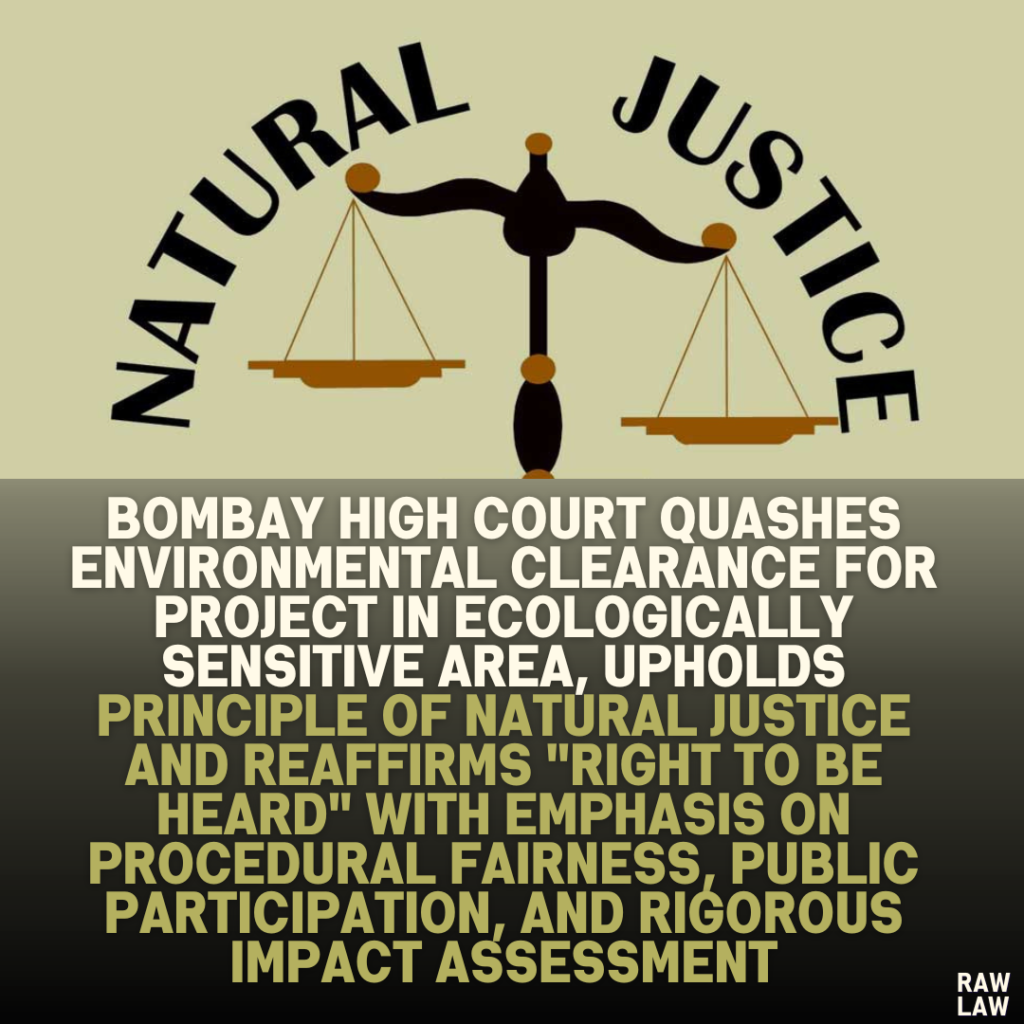Court’s Decision:
The Bombay High Court quashed the environmental clearance granted to a large-scale project in an ecologically sensitive area. The court determined that the principles of natural justice were violated because affected stakeholders were not adequately heard, and the clearance process lacked transparency. It ordered the project’s approval to be revisited, ensuring legal compliance and a participatory process.
Facts of the Case:
- A public interest litigation (PIL) was filed by concerned individuals and organizations opposing an environmental clearance granted to a development project proposed in an ecologically sensitive area.
- The petitioners alleged that:
- The environmental clearance was issued without providing sufficient notice or opportunity for local stakeholders to present their objections.
- The environmental impact assessment (EIA) process was flawed, as it ignored critical scientific data regarding biodiversity and ecosystem preservation.
- The project could adversely impact the local ecosystem, water bodies, and livelihoods dependent on agriculture and fishing.
- The respondents (developers and authorities) countered these claims, stating that they followed the procedures mandated by the law and that the clearance was granted after due diligence.
Issues Before the Court:
- Procedural Fairness: Was the environmental clearance issued in violation of the principles of natural justice, particularly the requirement for public consultation?
- Compliance with Environmental Laws: Did the clearance process comply with statutory provisions, including a detailed environmental impact assessment and consideration of objections from stakeholders?
Petitioner’s Arguments:
- Violation of Natural Justice:
- The petitioners contended that the clearance process ignored the basic principle of “audi alteram partem” (right to be heard).
- They argued that affected stakeholders, including local residents and environmental experts, were either not notified or given insufficient time to present objections.
- Inadequate Environmental Impact Assessment (EIA):
- The EIA failed to capture the project’s true environmental impact, including its potential harm to biodiversity, water sources, and local livelihoods.
- The petitioners alleged that the process lacked transparency and relied on incomplete or outdated data.
- Lack of Public Consultation:
- The petitioners highlighted that statutory requirements for public participation, including public hearings and consultations with affected communities, were not fully adhered to.
Respondent’s Arguments:
- Compliance with Law:
- The respondents maintained that the clearance was granted following all statutory requirements, including the preparation of an environmental impact assessment and conducting public hearings.
- Speculative Nature of Concerns:
- The respondents argued that the objections raised by the petitioners were speculative and not based on credible evidence of harm.
- Economic Development:
- They emphasized the project’s importance for regional economic development, stating that the benefits outweighed the perceived environmental risks.
Analysis of the Law:
- The court analyzed the relevant provisions of environmental laws, particularly those governing:
- Environmental Impact Assessment (EIA): The statutory requirement for a detailed scientific assessment of potential impacts.
- Public Participation: Provisions mandating adequate notice, public hearings, and the incorporation of stakeholder feedback in the decision-making process.
- The court noted that environmental governance hinges on transparency, inclusiveness, and procedural fairness. Any deviation undermines the legitimacy of decisions impacting the environment and public welfare.
Precedent Analysis:
The court referred to several precedents emphasizing:
- Natural Justice: The importance of hearing affected parties before granting clearances (e.g., procedural fairness cases in environmental disputes).
- Environmental Governance: The judiciary’s role in ensuring that environmental decisions adhere to legal and ethical standards to protect ecological balance and public health.
Court’s Reasoning:
- Violation of Natural Justice:
- The court found that the clearance process bypassed statutory obligations to involve local stakeholders meaningfully.
- It highlighted the necessity of respecting the “right to be heard” in decisions with far-reaching consequences.
- Flawed Environmental Impact Assessment:
- The court observed deficiencies in the EIA report, including the omission of critical environmental data and the failure to address cumulative environmental impacts.
- Lack of Public Consultation:
- The court noted procedural irregularities in notifying affected communities and conducting public hearings, rendering the clearance process non-compliant with legal standards.
Conclusion:
The Bombay High Court quashed the environmental clearance and directed the authority to restart the approval process. The revised process must:
- Comply fully with statutory requirements.
- Ensure meaningful public participation.
- Conduct a comprehensive environmental impact assessment.
The court reiterated the importance of procedural fairness, stating, “Environmental decisions affecting public interest cannot be taken in an opaque or arbitrary manner, as they must balance developmental goals with ecological preservation.”
Implications:
- The judgment strengthens the role of the judiciary in upholding environmental governance and ensuring that administrative decisions adhere to natural justice principles.
- It reinforces the statutory obligations of developers and authorities to involve stakeholders and conduct rigorous impact assessments for projects in sensitive areas.
- The case sets a precedent for future challenges to environmentally impactful projects, emphasizing that procedural fairness is non-negotiable.
